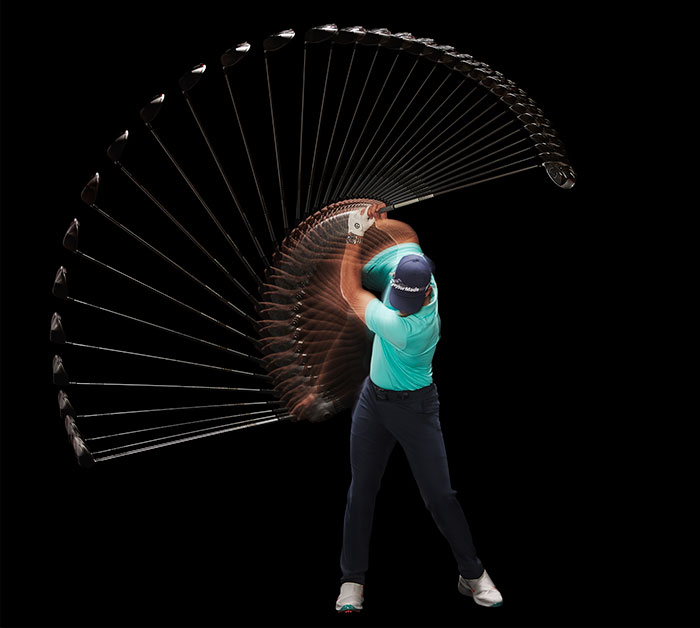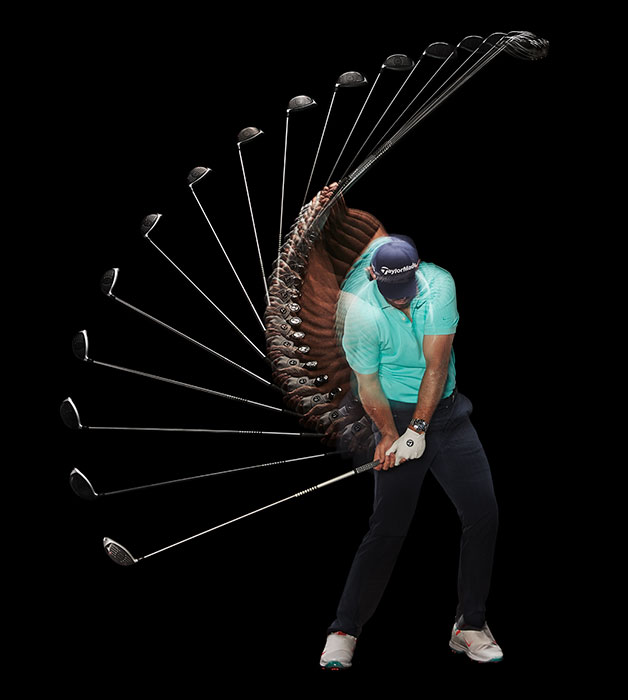For the remaining few who argue that the modern golf swing is in a slow creep towards production-line sameness, July 2019 was a rather disastrous month. That’s when Matthew Wolff, a 20-year-old PGA Tour rookie playing in his fourth event, lifted, looped, squatted, jumped and powered his way to victory at the 3M Open in Minnesota. Never mind that he blithely rolled in a bomb on the last hole for the win. It was his full swing that had everyday fans – and more than a few smart teaching traditionalists – hitting rewind, squinting and smiling as they tried to comprehend what they were seeing.
What they witnessed was an unorthodox power player who, unlike previous weird-swing wonders such as Jim Furyk, Miller Barber and Eamonn Darcy, delivers a blazing 132 miles per hour of clubhead speed with the driver. Wolff is as straight as he is long, with no glaring weaknesses through the bag. His coach, George Gankas, says that Wolff scored an impressive 92 on the TrackMan Combine, a launch-monitor challenge that tests ball-striking from 10 distances (84 is the tour average). His short game and putting have been called “spooky good”.
Wolff’s swing, the outline of which was in place at age 14 when he began working with Gankas, has been refined, but not dramatically, from the action he adopted intuitively as a child. The curious-looking aspects are in his golf-DNA, comfortable and familiar. Conversely, the parts that matter most – his enormous turn,
awesome sequence of motion and method of squaring the club – have been perfected during a decade of practice. Though most swings of players barely out of their teens are works in progress, Wolff’s swing is where he and Gankas say they want it permanently. It’s a low-impact swing physically, as natural to Wolff as walking. And judging by his ball flight when you watch him in person, it could make him a force in the years to come.
It’s so effective, it begs the question: should you swing like Wolff? “Sure you can, but it comes with some qualifiers,” Gankas says. “If you can turn on the backswing like Matt, it’s a great way to go, loop and all, because you’ll be able to position the club beautifully on the way down. But let’s be honest, not many people have his flexibility or athleticism.
“But you definitely can copy his posture at address, which is ideal. You can copy his sequence of motion on the downswing, which happens from the ground up regardless of your technique. And you definitely can learn to bow your left wrist on the downswing, which will make for a very effective impact.”
Now it’s time to turn the page, observe the unique stroboscopic photographs and marvel at his unique method.
“Before he swings, he rehearses the position he wants his shoulders and hips at impact.” George Gankas
Pre-swing
the strangest ignition in golf
When Wolff was 16, he broke his left collarbone after crashing to the turf in a game of touch football. After he healed, in an act of self-preservation, he resisted rotating his shoulders aggressively through the hitting area, which produces the slightly open position most good players have at impact. The result was square shoulders, a swing path that was excessively in to out and a clubface slighlty open. That meant blocks, shots that fly straight but right of the target line.

Wolff began rehearsing the position he wanted at impact – shoulders open, hips clearing, right knee angled towards the target [above] – before returning to a conventional address position [below]. During the rehearsal move, Wolff also reminds himself to rotate everything freely to obtain that shoulders-open look. Call it what you like – an ignition move, swing trigger or an old-fashioned sashay – but the quirky action has improved his swing path and ability to square the clubface at impact. He performs the move even on half-wedge shots.

Backswing
a lift, then enormous turn
Starting back, he takes the clubhead well outside the target line, and the clubface remains closed because he doesn’t rotate his forearms. Until the club is halfway back, it’s an arms-only swing with no wrist cock and very little motion of the torso. Then the fun begins. Wolff lifts his arms abruptly, his upper right arm flying away from his side, his left arm on a near-perfect vertical. At the same time, he turns his hips as far as he can, his left foot rising up on its toes and his right leg straightening to accommodate [below]. His shoulders turn enormously, too, which helps transport the club well “across the line”, the shaft aligned noticeably right of the target. The lift-and-turn action makes the club feel light. His posture and spine angle remain unchanged from address. Another tradition-upsetting element of Wolff’s backswing is the huge hip turn. Gankas believes the hips should turn considerably, which runs contrary to the idea that the pelvic rotation should be at least somewhat limited to create resistance between the lower body and upper body. The unlimited turn – notice that Wolff remains in perfect balance – also sets up a more flowing transition into the downswing.

From The Top
Re-routing with a loop
What happens from the top is unorthodox and the gasp-inducing signature of Wolff’s swing. Early on during the downswing, the club traces a loop as it moves from across the line into a more classic “slotted” position halfway down. The loop might look odd, but it’s rational. Gankas says that baseball players (Wolff’s favourite sport until his early teens) start with the bat vertical and then drop it onto a shallower plane so it’s moving horizontally as they stride into the pitch. Like a baseball player, Wolff starts the forward motion by shifting his weight to his left and unwinding his lower body as aggressively as possible. His upper right arm returns to his side, carried there by the unturning of his hips and shoulders. His body rotation is sequenced from the ground up and happens so well, the hands and club move onto the correct plane and path with no conscious thought [below]. Despite the incredible speed he’s generating, there’s no tension in his arms. His hands are just holding on.

The Impact Zone
Powering through the ball with his legs
As his downswing progresses, Wolff performs a Sam Snead-like squat, his knees bending and separating as he applies downward pressure to the ground with his feet [below, top]. Gankas calls this deliberate move “digging” and says that Wolff does it in concert with his hips unturning furiously. “I love the way he squats and lowers himself,” he says. “I call it ‘eating the golf ball’. It sets him up to deliver unbelievable power.” The unturning of the hips as Wolff squats is so aggressive, he twists and grinds his feet into the ground. “Matt is a range destroyer,” Gangkas says. “He tears up the turf with his spikes. I can always identify the spot where he’s been practising.” Then, as Wolff nears impact, he thrusts upward from the balls of his feet, his body still turning [below, middle]. The combination of movements, along with his remarkable arm and hand speed, produces a tonne of raw power. Wolff, a feel player who unlike Gankas isn’t inclined to dissect the mechanics of his swing, has one thought through impact. “I think, clear,” he says. “It’s a feeling more than a thought. I want to feel unrestricted, to keep swinging even after the ball is gone [below, bottom]. It’s a sensation of freedom, like nothing is in my way.”




